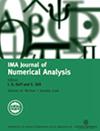参数偏微分方程的变差校正神经残差回归:关于控制精度的可行性
IF 2.4
2区 数学
Q1 MATHEMATICS, APPLIED
引用次数: 0
摘要
本文是关于学习偏微分方程(PDEs)系统的参数-解映射,这些系统依赖于潜在的大量参数,涵盖了可以找到稳定变分公式(SVF)的所有PDE类型。一个中心组成部分是变差校正残差损失函数的概念,这意味着它的值总是与SVF确定的范数中的平方解误差均匀成正比,因此便于严格的后验精度控制。它是基于一个单一的变分问题,与参数相关的纤维问题族,采用希尔伯特空间的直接积分的概念。由于损失函数的原始形式是作为残差的对偶检验范数给出的;一个中心目标是发展等价的可计算表达式。第一个关键角色是混合假设类,其元素是(低维)时空变量的分段多项式,具有参数相关系数,可以通过神经网络表示。其次,使用一阶svf,我们区分了两种情况:(i)测试空间可以选择为$L_{2}$-空间(例如椭圆或抛物线问题),以便残差可以直接作为$L_{2}$的元素进行评估;(ii)当光纤问题的试验和测试空间取决于参数(如输运方程)时,我们使用超弱公式。结合不连续的Petrov-Galerkin概念,混合格式有助于得到变差正确的可计算残差损失函数。我们的研究结果通过代表(i)和(ii)的数值实验来说明,即具有分段恒定扩散系数的椭圆边值问题和具有参数依赖对流场的纯输运方程。本文章由计算机程序翻译,如有差异,请以英文原文为准。
Variationally correct neural residual regression for parametric PDEs: on the viability of controlled accuracy
This paper is about learning the parameter-to-solution map for systems of partial differential equations (PDEs) that depend on a potentially large number of parameters covering all PDE types for which a stable variational formulation (SVF) can be found. A central constituent is the notion of variationally correct residual loss function, meaning that its value is always uniformly proportional to the squared solution error in the norm determined by the SVF, hence facilitating rigorous a posteriori accuracy control. It is based on a single variational problem, associated with the family of parameter-dependent fibre problems, employing the notion of direct integrals of Hilbert spaces. Since in its original form the loss function is given as a dual test norm of the residual; a central objective is to develop equivalent computable expressions. The first critical role is played by hybrid hypothesis classes, whose elements are piecewise polynomial in (low-dimensional) spatio-temporal variables with parameter-dependent coefficients that can be represented, for example, by neural networks. Second, working with first-order SVFs we distinguish two scenarios: (i) the test space can be chosen as an $L_{2}$-space (such as for elliptic or parabolic problems) so that residuals can be evaluated directly as elements of $L_{2}$; (ii) when trial and test spaces for the fibre problems depend on the parameters (as for transport equations) we use ultra-weak formulations. In combination with discontinuous Petrov–Galerkin concepts the hybrid format is then instrumental to arrive at variationally correct computable residual loss functions. Our findings are illustrated by numerical experiments representing (i) and (ii), namely elliptic boundary value problems with piecewise constant diffusion coefficients and pure transport equations with parameter-dependent convection fields.
求助全文
通过发布文献求助,成功后即可免费获取论文全文。
去求助
来源期刊
CiteScore
5.30
自引率
4.80%
发文量
79
审稿时长
6-12 weeks
期刊介绍:
The IMA Journal of Numerical Analysis (IMAJNA) publishes original contributions to all fields of numerical analysis; articles will be accepted which treat the theory, development or use of practical algorithms and interactions between these aspects. Occasional survey articles are also published.

 求助内容:
求助内容: 应助结果提醒方式:
应助结果提醒方式:


